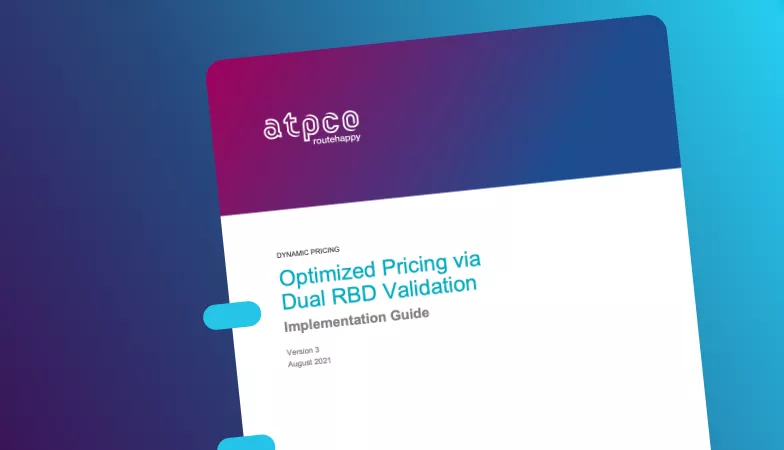On demand | Elevate 2021
British Airways and Dual RBD: A path to dynamic offer creation
CASE STUDY • DYNAMIC OFFER CREATION
A key ingredient when transitioning to dynamic offer generation and advanced retailing is having the flexibility of more than 26 price points. ATPCO’s Dual RBD is a simple, interoperable solution that allows you to introduce and manage more price points that support targeted pricing. British Airways shares how using Dual RBD is just one tool on the road to Dynamic Offer Creation and discusses ATPCO’s future role in enabling more capabilities at scale.
Dynamic offer generation is a powerful aspect of advanced retailing
Across the industry, airlines, revenue management experts, and data scientists are exploring how to create offers in real time without the constraints of legacy systems and pricing methodologies. But practically speaking, that future is years away, so what can be done now to enable more flexible and targeted offers?
ATPCO’s Dual RBD is an interoperable solution that enables airlines to move beyond the constraints of 26 price points. Having access to a more robust, expanded set of possible price points (up to 182!) unlocks new opportunities for airlines to compete for travelers and grow revenue. The solution leverages capabilities in place today and is therefore easy and fast to implement.
Over 55 airlines are using Dual RBD today and see it as a significant step forward in the path to true dynamic pricing.
British Airways was an early adopter of Dual RBD. The airline sought to improve its ability to compete with large low-cost carriers, the majority of which have no limitations on price points. Implementing Dual RBD solved this problem by offering multiple price points in the marketplace, resulting in tangible revenue gains. Because Dual RBD uses existing functions, it was interoperable with other pricing in the market and flowed seamlessly through all systems, including settlement.
Narrator
26 letters in the alphabet used to mean 26 price points for airlines. That is no longer the case. Airlines have more flexibility with ATPCO's Dual RBD, which introduces more price points to the market for airlines everywhere.
Join us now as we hear from British Airways on how they are innovating on the road to dynamic offer creation, and how ATPCO will be leading the future for dynamic pricing at scale.
Tom
I'm pleased to be joined today with Jerry Foran from British Airways, who happens to be the chairman of the ATPCO board of directors.
Jerry, I think you and I have been around the world several times at many different conferences, but I don't think we've ever been on stage together. And this is, maybe we're not on the same stage, but we're on a virtual stage together for the first time talking about Dual RBD and how to create dynamic offer creation for the industry.
Jerry
Thanks, Tom. Actually I do think we have been on one panel, but for the life of me, I can't remember what it was. But we were on a panel arguing about something but I can't remember what it was now, a few years ago.
Tom
Well, excellent.
I hope today we agree about something.
Tom
I'm sure we will.
Jerry
I'm sure we will.
Tom
So I want to set context for the message. So ATPCO is really here to help airlines retail their product.
That includes the creation of the product, the distribution of the product, the display of the product, and then of course the servicing and settlement of the product.
We know that these needs evolve over time and we've really been passionate about trying to evolve our capabilities to build the most sophisticated methodologies in order to do all of these aspects.
We don't take the trust of the 400 airlines that use these services lightly, and we are continuing to be focused on innovating in these different areas.
One of the areas of innovation that's very critical for dynamic offer creation and airline retailing is really about the price itself, and there's been a lot of discussion over the last few years on how to get more to a continuous pricing methodology.
On this slide, you'll see that we've defined dynamic pricing really into three different buckets. We have it as optimized pricing, and then we have dynamic price adjustments, and we have continuous pricing.
And on the grid you can see that as you go up in the science methodology on the right, it becomes more time and more effort in order to implement a change.
We really have heard a lot of constraints from the industry. One of the constraints we've heard over and over again is really the limitation of RBDs of the 26 letters that can be used to price points in areas.
So I want to talk a little bit first on Dual RBD and how that maybe unlocks some of those constraints in the industry. We implemented Dual RBD a couple of years ago and in a new way.
It's actually been around for many, many decades for upgrades and for other processes, but we saw a way that we could actually leverage Dual RBD where you can actually apply one booking class, a B class, and say it's only available if this other class, an X class, is available. We call that primary and secondary. That methodology actually changes the number of buckets, if you will, 26 letters, to actually go to a more robust set of price points. You can get up to 182 price points if you divide up your buckets into primary and secondary classes.
It's been a very popular thing for us to implement, over 55 airlines are now using Dual RBD capabilities, and BA actually as one of the earlier adopters of Dual RBD.
I actually want to turn it over to you now, Jerry, and say, how did that process go for you, and what was BA's experience in implementing Dual RBD?
Jerry
Well, it was a great project to work on.
The team, or several teams across revenue management and elsewhere, that worked on it, and it was a great thing to be able to do.
It wasn't particularly costly, particularly when you look at the benefits that we've achieved from it. It was answering a need that we had at the time, an urgent need.
We were, we have a lot of competition from some very large low-cost carriers, for example, and they don't have any such limitations on price points, or most of them don't. So we definitely had a need in order to be able for us to compete in the marketplace and be more relevant.
And also we needed it to ensure that we had something that would still combine and be interoperable with all of our other pricing that was in the market. And of course it needed to flow seamlessly through all of our systems including settlement, which indeed it does.
I think for us it's been a great success. It isn't the end of the story. Clearly it's the start of a journey moving away from traditional pricing, if you like, using the old capabilities, which of course we're still using as well in tandem, but this is certainly a start.
It's been great for us. It might not be where others want to start, and it's certainly, like I said, it's not the end, it's just part of a toolkit that we'll use as we move forward into the new retailing world.
Tom
Excellent, Jerry. And maybe just to continue on with that theme, you talked about there's other things that need to happen. Can you expand upon that, or what you think also needs to happen in order to move to a dynamic offer creation module?
Jerry
Well, we need to be able to, at the same time, it's not just about price, it's about the product itself and what's included in that product.
And so we need to be able to display in all of the channels where we wish to sell our products, the combination of that price and product. And we, as I said, we need to be able to do it in all channels and we need to be able to let the customer know exactly what it is they're purchasing, and of course we need to, whatever these new capabilities are as they develop going forward, we need to be able to service and and also to settle them, which is clearly very important for any airline.
Tom
Excellent, and maybe going on to, I know you've been really active as British Airways in the industry forums, including the ATPCO and IATA forums, in order to extend these capabilities. Can you share a little bit on why that's an important part of being able to create your capabilities? Why doesn't the airline just build it all themselves?
Jerry
Because we can't. I mean, it just doesn't work that way.
I mean, if you've got a single distribution channel and you're not going to interline with anyone, you don't want to work with partners, or even competitors, in order to extend your network reach. If you can achieve that, then perhaps that's fine, but we work in a connected air transportation system, and therefore it's very important, it's vital, in fact, that we work together with the industry, with ATPCO, and to ensure that the products that we do develop can be sold and seen by whoever we want to see them.
Tom
Excellent, excellent.
I'm going to ask you to switch your hats a little bit. I introduced you as also our chairman of the ATPCO board. I want you to put on your chairman hat a little bit and tell me, Tom at ATPCO, what you think is the priorities that you see that we should have in order to help extend these capabilities and dynamic offer creation.
Jerry
Well, I think both myself and the rest of the board believe that ATPCO is ideally placed to support and even drive the transition. ATPCO is uniquely placed as a industry utility, it's owned by the airlines, it has the airline's interests in mind, and so it's perfectly positioned.
In order to do this. We've done, ATPCO has delivered capability to airlines for the last 50 years and has been a key player in setting the standards and utilities for these new capabilities as they've come out.
So it's absolutely critical, I think, that ATPCO plays a strong role in this. And as I've said, that's the view of both myself and the board, and we look forward to working with ATPCO in the coming years.
Tom
Thank you. Excellent.
With that, I want to share a little bit that we have actually identified six themes that the industry needs to work on together in order to evolve dynamic offer creation, and that's these on the screen here.
We at ATPCO, we aren't starting from ground zero. As Jerry mentioned, we've actually built a lot of the capabilities over the many years and decades, and we will continue to build them out.
We're currently on a journey that you're going to hear more about in the Elevate conference. We're moving to the cloud and we're creating more of a view of what does the next generation of distribution needs to look like.
We have done work with the NGS project and you'll hear more about that and how to better display and retail the product offering, and then we continue to work on dynamic pricing.
And there's two things that I would like to actually share with you on dynamic pricing, is that if you are a carrier today that you're feeling constrained by 26 booking classes, that's not true anymore.
You can find ways to get more price points and more products out in the marketplace and be able to extend it in the current ecosystem. So you can use that Dual RBD capability, and you can reach out to us and we can tell you how to do that.
If you want to get involved in creating the new solution and new dynamic offer creation together, then join one of the design groups. We'll work on these six items together and try to evolve them through our industry governance and standards process to make sure that it creates a capability that's scalable for the world.
So with that I want to close, and thank you, Jerry, for all your time and your input into this topic. And thank you for all the support over the many years, and thank you for participating in the design groups as we move forward in order to help evolve the industry.
Jerry
Thank you, Tom.
Narrator
What a few days it’s been, and what a way to end. Thank you to each of you who have taken time out of your busy days to join us and learn more about key initiatives and perspectives that are shaping our industry.
Our industry and the world have had a tough 18 months, but from challenges come new ideas and more innovation so we can collectively level up. ATPCO is humbled to have had you join us these last couple of days.
The game is not over when the conference ends. ATPCO is your player two, your partner in reaching your goals, and we look forward to continuing the conversation soon.
Speakers

Tom Gregorson
Chief Strategy Officer, ATPCO
For over 25 years, Tom has been working to develop products that enhance the travel industry. Throughout his career, he has gained insight and provided leadership through his various roles at airlines and global distribution systems, and with ATPCO since 1996. In his current role, Tom leads the Strategy organization and is responsible for creating the long-term vision for ATPCO and exploring new business ventures. His focus is on industry standards and effective ecosystem governance, as well as driving forward concepts like dynamic pricing and tax automation. Tom has built a reputation for being a thought leader and implementer of industry solutions in the distribution space.

Jerry Foran
Head, Product Delivery, Global Revenue, British Airways
With more than forty years and several management positions within the commercial area, Jerry now leads a three-year program to upgrade BA's revenue management capability to ensure it can take advantage of developments in price and inventory distribution. For three years, Jerry was based in Japan as commercial manager. He has extensive revenue management experience, including project managing BA’s team on the Amadeus Altea Inventory project during its specification stage. He also serves as ATPCO’s chair of the board, member of the ATPCO board Executive and Nominating Committees, chair of the IATA Passenger Tariff Conferences Steering Group, BA's voting representative on the IATA Joint Passenger Services Conference (JPSC), member of IATA's Passenger Distribution Group (PDG) looking at New Distribution Capability (NDC), and member of IATA's PDG Advisory Forum.
You might also like



